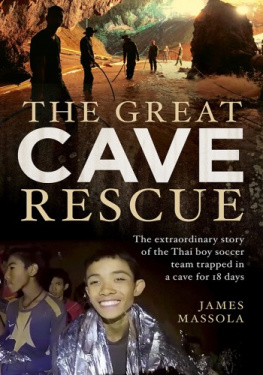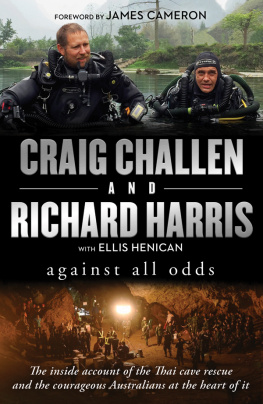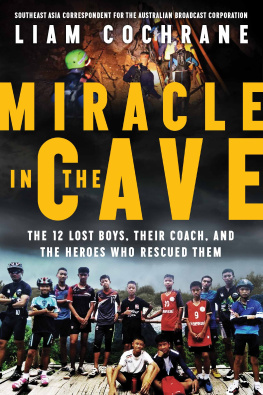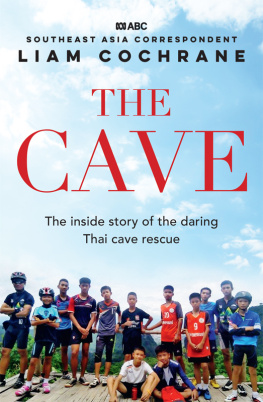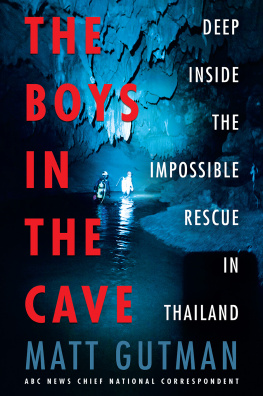James Massola is South-east Asia correspondent for Fairfax Media. He was previously chief political correspondent for The Sydney Morning Herald and The Age , based in Canberra. He is the winner of a Quill award for investigative journalism and has been a Walkleys and Quills finalist on two other occasions. He was on the ground at Tham Luang cave for the rescue operation.
First published in 2018
Copyright James Massola 2018
All rights reserved. No part of this book may be reproduced or transmitted in any form or by any means, electronic or mechanical, including photocopying, recording or by any information storage and retrieval system, without prior permission in writing from the publisher. The Australian Copyright Act 1968 (the Act) allows a maximum of one chapter or 10 per cent of this book, whichever is the greater, to be photocopied by any educational institution for its educational purposes provided that the educational institution (or body that administers it) has given a remuneration notice to the Copyright Agency (Australia) under the Act.
Allen & Unwin
83 Alexander Street
Crows Nest NSW 2065
Australia
Phone: (61 2) 8425 0100
Email:
Web: www.allenandunwin.com

ISBN 978 1 76052 974 1
eISBN 978 1 76087 006 5
Map by Darian Causby
Set by Midland Typesetters, Australia
Cover design: Blue Cork
Front cover photographs: Courtesy of the Thai Navy SEALs
For the tiny one, Sabina. The twins, Carlo and Giacomo.
For those who came before.
For those who should still be here.
For my parents, Carlo and Rose.
And for Karen Jane, most of all.
CONTENTS
I honestly thought there was zero chance of success.
DR RICHARD HARRIS
I cant emphasise enough how dangerous it was for the kids.
It was absolutely life and death.
CRAIG CHALLEN

THE WILD BOARS
Coach Ekapol Ek Chantawong (25)
Mongkol Mark Boonpiam (13)
Somepong Pong Jaiwong (13)
Pornchai Tee Kamluang (16)
Pipat Nick Pho (15)
Duganpet Dom Promtep (13) (captain)
Panumas Mick Sangdee (13)
Adul Sam-on (14)
Peerapat Night Sompiangjai (17)
Prajak Note Sutham (14)
Nattawut Tle Takamrong (14)
Chanin Titan Vibulrungruang (11)
Ekarat Bew Wongsukchan (14)

Nopparat Nop Kanthawong (senior coach)
Songpol Kanthawong (13)
Thaweechai Nameng (13)
THE DIVERS
Josh Bratchley (British)
Erik Brown (Canadian)
Dr Craig Challen (Australian)
Robert Harper (British)
Dr Richard Harris (Australian)
Chris Jewell (British)
Ivan Karadzic (Danish)
Jason Mallinson (British)
Mikko Paasi (Finnish)
Claus Rasmussen (Danish)
Ben Reymenants (Belgian)
Connor Roe (British)
Rick Stanton (British)
John Volanthen (British)
Jim Warny (Belgian)
ROYAL THAI ARMY
Dr Pak Loharnshoon
Major General Chalongchai Chaiyakham, Deputy
Commander of the Third Thai Army
THAI NAVY SEALS
Rear Admiral Arpakorn Yuukongkaew, Commander
Captain Anan Surawan
Sergeant Saman Gunan (retired)
THAI OFFICIALS
Prayut Chan-o-cha, Prime Minister of Thailand
Narongsak Osatanakorn, out-going Governor of Chiang Rai
Province and chief of the rescue mission
Weerasak Kowsurat, Minister of Tourism and Sports
Anupong Paochinda, Interior Minister
CAVE EXPERTS
Martin Ellis (British cave expert)
Robert Harper (British)
Kamol Lak Khunngarmkuamdee
Chaiporn Siripornpibul, speleologist with Thailands Mineral
Resources Department
Vernon Unsworth (British, Thai-based)
THAI VOLUNTEERS
Birds nest collectors, Koh Libong, Trang Province
Panom Cheunpiron, pump supplier
And a cast of thousands
RESCUE COORDINATORS
Mike Clayton, equipment needs
Gary Mitchell, communications
AUSTRALIA
Divers from the Specialist Response Group, Australian
Federal Police, and the Australian Navy
BRITAIN
Bill Whitehouse, Vice Chairman, British Cave Rescue Council
Emma Porter, Secretary, British Cave Rescue Council
CHINA
Wang Yingjie, leader of a team of rescuers from the Beijing
Peaceland Foundation
Green Boat Emergency
UNITED STATES
Major Charles Hodges, US Mission Commander
Master Sergeant Derek Anderson, Dive Operations
Commander
Search and rescue team from 31st Rescue Squadron
Airmen from the 353rd Special Operations Group

June marks the beginning of the rainy season in Mae Sai. The days are long, with twilight beginning soon after 5 am and dusk not arriving until after 7 pm. The sun is at its hottest just after midday but, during the summer months of June, July and August, the heat creeps up on you. Fog and mist, rolling down from the nearby Doi Nang Non mountain rangethe Mountain of the Sleeping Lady, in the local tongueis not uncommon at dawn, fooling unprepared visitors in the early hours of the morning.
If it has rained overnight, a jacket often seems like a good idea during the first couple of hours after sunrise. Mid-mornings are decidedly pleasant, too, as the temperature idles its way through the mid-20s. But it keeps creeping up and, sometime after midday, as the mercury reaches 30C and the heat and humidity take hold, youre like the proverbial frog in the pot who failed to realise the water was slowly boiling. Suddenly youre sweating, your feet feel trapped in closed-toe shoes and that jacket becomes just an extra item to carry. The heat remains for long stretches of the afternoon and in summer the ever-present threat of rain suffuses the air with moisture; the humidity can rise above 90 per cent.
In this part of the world, you can usually smell the rain before you feel it. The air you breathe becomes a little heavier, its odour somehow a little thicker andout in the fields and backroads that lead to the Tham Luang Nang Non cave complexthe dirt beneath your feet, which never has quite enough time to dry out, somehow readies for the rain to fall. A few moments before the rain begins the breeze gives the game away, quickening and cooling as it brushes an exposed cheek or arm. A drop or three, then the water descends. If you dont take cover almost immediately, youre soaked through to the bone.

Phahonyothin Road, which cuts through the centre of Mae Sai, is neatly divided by a row of well-tended trees and shrubs. Along this main street old and tired two-, three- and fourstorey buildings sit side by side. Down side roads and alleyways, the houses are even more modest. Mae Sai is a small town in a neglected northern corner of Thailands Chiang Rai Province850 kilometres from the hustle and bustle of Bangkok, home to the countrys political and business elite.
The shop-owners and stallholders on the towns main road are adept at dealing with these downpours of course, but the people on each side of the street tend to handle the rain in a distinctly different way. On the western side, where the stalls, markets and carts are thickest, many of the stallholders band together and run long stretches of plastic sheeting from the shop-front walls to their carts on the road. These market stallswhich sell T-shirts, brightly coloured jewellery, roasted nuts, noodles and an array of local delicaciesare jammed next to each other with no apparent regard for the (probably non-existent) occupational health and safety laws. The sheeting, a temporary affair, is slung so low that its at decapitation height for anyone approaching 6 feet tall. But for the shoppers who promenade up and down, casting their eyes over the goods, it does offer some protection from sudden downpours.
Next page
